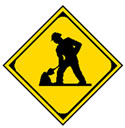 Construction sites and equipment present many hazards if proper care is not taken. The space in and around a construction site is often filled with potentially dangerous, high-powered equipment capable of delivering high forces. Construction sites are also often busy and congested with many people performing a variety of tasks. This complex situation is compounded by the fact that there is typically limited space and visibility available to workers. As a result, there are a wide range of construction accidents involving falls, conveyors, heavy machinery and vehicles, handheld tools, safety harnesses, head, eye and hand protection, and scaffolding and ladders.
Construction sites and equipment present many hazards if proper care is not taken. The space in and around a construction site is often filled with potentially dangerous, high-powered equipment capable of delivering high forces. Construction sites are also often busy and congested with many people performing a variety of tasks. This complex situation is compounded by the fact that there is typically limited space and visibility available to workers. As a result, there are a wide range of construction accidents involving falls, conveyors, heavy machinery and vehicles, handheld tools, safety harnesses, head, eye and hand protection, and scaffolding and ladders.
Expertise
We have extensive experience in many aspects of construction accidents including:
- Scaffolding and safety harness use issues
- Construction vehicle operation
- Power tool use and misuse
- Safe head, eye and hand protection
- Excavating and cave-ins
Questions Answered
Through scientific analysis, we can help you answer pertinent questions such as:
- Was the scaffolding properly designed and built?
- Would proper head protection have prevented an injury?
- Was the proper loading/unloading procedure followed?
Case Examples
Fall from machine due to lack of handholds:
A fuel delivery man had just finished refueling a backhoe at a construction site and began to climb down from the machine. After lowering the fuel hose to the ground, he began to descend using a rope that had been tied to the side of the machine. He lost his footing on the machine's tread and slammed into the side of the machine, falling to the ground. We showed that the rope was inadequate due to its flexibility. We further showed that there were too few handholds to allow safe climbing.
Dump Truck Loading:
A dump truck driver was sitting in the cab as his truck was being loaded with earth material. He was allegedly thrown into the roof by the force of the load deposited into the dump body. The plaintiff claimed that this impact caused him spinal injures. We demonstrated, with a combination of truck and biomechanical modeling and testing, that even a full payloader bucket would not have caused a large enough truck vibration to have caused the driver to strike his head on the cab ceiling.
Kristopher J. Seluga, PE, is a Mechanical Engineering, Accident Reconstruction, Biomechanics, and Safety Expert with over 20 years of experience. He received his Bachelor's and Master's degrees from the Mechanical Engineering department at MIT where he worked on the development of novel three-dimensional printing technologies. Mr. Seluga is also a licensed Professional Engineer in New York and Connecticut, and has served as a member of the ANSI engineering committee for the Z130.1 and Z135 standards for golf cars and PTV's. His research interests and peer reviewed publications span the topics of Motor Vehicle Dynamics, Product Safety, and Biomechanics.
©Copyright - All Rights Reserved
DO NOT REPRODUCE WITHOUT WRITTEN PERMISSION BY AUTHOR.



 Construction sites and equipment present many hazards if proper care is not taken. The space in and around a construction site is often filled with potentially dangerous, high-powered equipment capable of delivering high forces. Construction sites are also often busy and congested with many people performing a variety of tasks. This complex situation is compounded by the fact that there is typically limited space and visibility available to workers. As a result, there are a wide range of
Construction sites and equipment present many hazards if proper care is not taken. The space in and around a construction site is often filled with potentially dangerous, high-powered equipment capable of delivering high forces. Construction sites are also often busy and congested with many people performing a variety of tasks. This complex situation is compounded by the fact that there is typically limited space and visibility available to workers. As a result, there are a wide range of 







